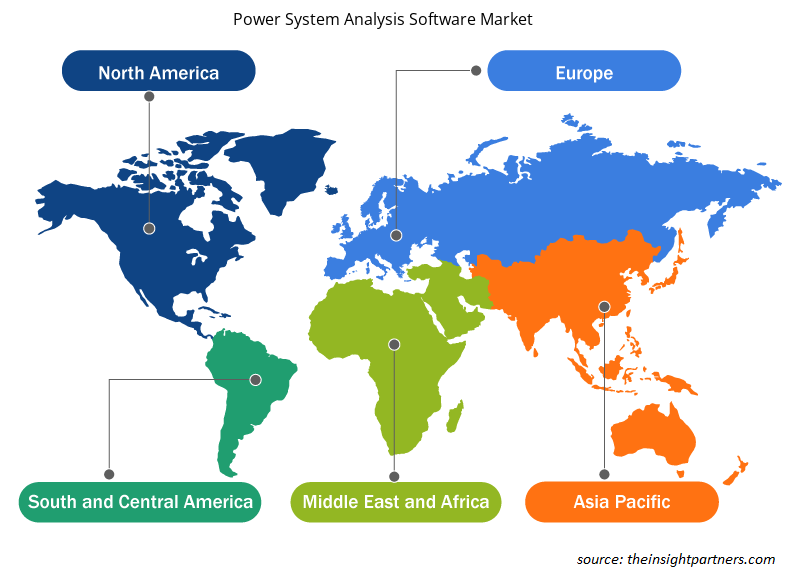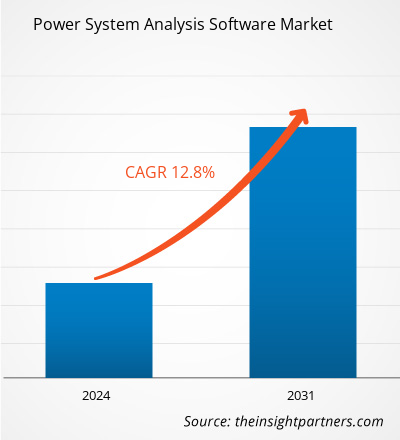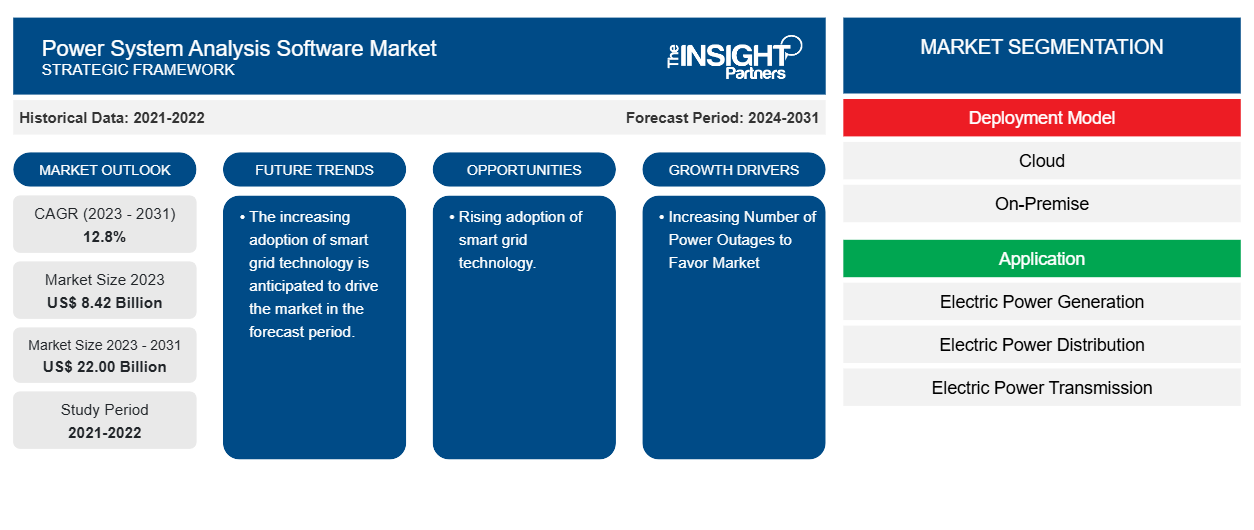电力系统分析软件市场规模预计将从 2023 年的 84.2 亿美元增至 2031 年的 220 亿美元。预计 2023-2031 年期间,该市场的复合年增长率将达到 12.8%。停电次数增加,电力需求增加。此外,政府对能源管理的举措不断增加以及智能电网技术的采用不断增加,这些可能是电力系统分析软件市场的主要驱动因素和趋势。
电力系统分析软件市场分析
近年来,对优化电力管理的需求日益增长。业务运营越来越依赖云和先进的自动化系统。因此,电力行业对软件解决方案的采用日益增加,推动了电力系统分析软件市场的发展。此外,电力系统分析软件有助于提供更好的电流分析并最大限度地降低风险。
电力系统分析软件市场概览
电力系统分析软件包括解决方案和服务,使企业能够通过高效的电力管理、降低能源成本和自动化来提高销售额。借助自动化和分析,电力系统分析软件旨在对电力系统进行数据分析、建模和仿真。该软件有助于分析和诊断电力系统中的任何故障。它还通过通知操作员电力系统中的异常情况来帮助提高安全性。
定制此报告以满足您的需求
您可以免费定制任何报告,包括本报告的部分内容、国家级分析、Excel 数据包,以及为初创企业和大学提供优惠和折扣
- 获取此报告的关键市场趋势。这个免费样品将包括数据分析,从市场趋势到估计和预测。
电力系统分析软件市场驱动因素和机遇
停电次数增加有利于市场
人们和组织在几乎所有的运营中都高度依赖电力。因此,需要持续不断的电力供应。然而,由于天气条件变化、风暴和电力基础设施老化,全球停电次数有所增加。电力系统分析软件可以帮助预测恶劣天气导致的停电情况。它可以即时分析受损网络的位置和损坏程度。它观察损坏情况并指出必要的行动。它建议资源需求,派遣维修人员,并向外部和内部传达关键的损坏和更新信息。
智能电网技术的应用日益广泛
随着生活水平的提高、城市化、可支配收入的提高以及先进技术的采用,能源需求每天都在增加。由于全球住宅和商业部门的需求激增,电力利用率也随之上升,这导致电网变得复杂。随着电网复杂性的增加,对可持续、高效、可靠和安全的电力生产和分配的需求也随之增加。随着电力消费和需求的出现,电力生产和分配变得越来越困难。为了应对这一挑战,电网变得更加智能,这个概念被称为智能电网。
电力系统分析软件市场报告细分分析
有助于得出电力系统分析软件市场分析的关键部分是部署模型、应用、电压类型和行业垂直领域。
- 根据部署模式,电力系统分析软件市场分为云端和本地部署。预计云端部分将在预测期内占据相当大的市场份额。
- 根据应用,电力系统分析软件市场分为发电、配电和输电。预计发电部门将在预测期内占据相当大的市场份额。
- 根据电压类型,市场分为低压、中压和高压。预计中压部分将在预测期内占据相当大的市场份额。
- 按行业垂直划分,市场分为石油和天然气、制造业、运输业、采矿业、可再生能源、不可再生能源和其他行业。预计石油和天然气行业在预测期内将占据相当大的市场份额。
电力系统分析软件市场份额(按地区)分析
电力系统分析软件市场报告的地理范围主要分为五个区域:北美、亚太、欧洲、中东和非洲、南美和中美。
北美一直主导着电力系统分析软件市场。北美电力系统分析软件市场分为美国、加拿大和墨西哥。美国和加拿大是在其业务中采用新技术和自动化的先驱。互联网在该地区的高度普及,加上政府为促进采用数字技术以实现顺畅无缝的业务运营并最大限度地减少人为错误而采取的举措,正在催化整个北美地区电力系统分析软件的采用。所有这些因素都促进了该地区电力系统分析软件市场的增长。
电力系统分析软件市场区域洞察
Insight Partners 的分析师已详细解释了预测期内影响电力系统分析软件市场的区域趋势和因素。本节还讨论了北美、欧洲、亚太地区、中东和非洲以及南美和中美洲的电力系统分析软件市场细分和地理位置。

- 获取电力系统分析软件市场的区域特定数据
电力系统分析软件市场报告范围
| 报告属性 | 细节 |
|---|---|
| 2023 年的市场规模 | 84.2亿美元 |
| 2031 年市场规模 | 220亿美元 |
| 全球复合年增长率(2023 - 2031) | 12.8% |
| 史料 | 2021-2022 |
| 预测期 | 2024-2031 |
| 涵盖的领域 | 按部署模型
|
| 覆盖地区和国家 | 北美
|
| 市场领导者和主要公司简介 |
|
电力系统分析软件市场参与者密度:了解其对业务动态的影响
电力系统分析软件市场正在快速增长,这得益于最终用户需求的不断增长,这些需求源于消费者偏好的不断变化、技术进步以及对产品优势的认识不断提高等因素。随着需求的增加,企业正在扩大其产品范围,进行创新以满足消费者需求,并利用新兴趋势,从而进一步推动市场增长。
市场参与者密度是指在特定市场或行业内运营的企业或公司的分布情况。它表明在给定市场空间中,相对于其规模或总市场价值,有多少竞争对手(市场参与者)存在。
在电力系统分析软件市场运营的主要公司有:
- ETAP。
- ALPI 国际软件
- PowerCad 软件有限公司
- Trimble 公司
- 尼普兰股份公司
- ABB有限公司
免责声明:上面列出的公司没有按照任何特定顺序排列。

- 获取电力系统分析软件市场顶级关键参与者概览
电力系统分析软件市场新闻和最新发展
电力系统分析软件市场通过收集一手和二手研究后的定性和定量数据进行评估,其中包括重要的公司出版物、协会数据和数据库。电力系统分析软件市场的一些发展如下:
- Digsilent 发布 Powerfactory 的新服务包。Digsilent 发布了 PowerFactory 2023、2022 和 2021 的新服务包。PowerFactory 是 DigSlLENT 的电力系统分析软件,涵盖了从标准功能到高度复杂的功能的所有功能。该包支持将用户界面本地化为英语、德语、西班牙语、土耳其语、法语和中文等语言。该公司推出了 PowerFactory 2023 的预览版。(来源:Digsilent 公司网站,2023 年 1 月)
- 与 IBM Power Systems 合作的解决方案提供商期待服务器计算机系列至少拥有三个增长动力——SAP HANA、银行和行业优化以及一切即服务——Power 在过去八个季度中有六个季度通过生态系统实现了两位数增长。(来源:IBM,公司网站,2024 年 1 月)
电力系统分析软件市场报告范围和交付成果
“电力系统分析软件市场规模和预测(2021-2031)”报告对市场进行了详细的分析,涵盖以下领域:
- 范围内涵盖的所有主要细分市场的全球、区域和国家层面的电力系统分析软件市场规模和预测。
- 电力系统分析软件市场趋势以及驱动因素、限制因素和关键机遇等市场动态。
- 详细的 PEST/波特五力分析和 SWOT 分析。
- 电力系统分析软件市场分析涵盖主要市场趋势、全球和区域框架、主要参与者、法规和最新的市场发展。
- 行业格局和竞争分析涵盖市场集中度、热图分析、知名参与者以及电力系统分析软件市场的最新发展。
- 详细的公司简介。
- 历史分析(2 年)、基准年、预测(7 年)及复合年增长率
- PEST和SWOT分析
- 市场规模、价值/数量 - 全球、区域、国家
- 行业和竞争格局
- Excel 数据集
近期报告
相关报告
客户评价
购买理由
- 明智的决策
- 了解市场动态
- 竞争分析
- 客户洞察
- 市场预测
- 风险规避
- 战略规划
- 投资论证
- 识别新兴市场
- 优化营销策略
- 提升运营效率
- 顺应监管趋势





















 获取免费样品 - 电力系统分析软件市场
获取免费样品 - 电力系统分析软件市场